Become A GreenSlate Power User With These Time Saving Tips
Converting to a fully digital production accounting solution like GreenSlate is easy. These time savers and efficiency boosters unique to the platform will have you wondering how you ever lived without.
No matter your experience level, there’s always something you can learn to make your work less insurmountable.
I’ve put together a list of skills to master based on GreenSlate functionality from beginner, through intermediate, to advanced.
Of course, any one of these areas is accessible and fully usable for any skill level, but each builds upon the other, and together they will make you a GreenSlate Power User.
BEGINNER
It’s always good to master the fundamentals. The first three skills are essential. We must be able to find items, where they are in the approval flow and be able to prioritize them.
CUSTOM VIEWS
When using GreenSlate for the first time, you begin to realize how powerful and thoughtfully designed the user interface is.
I encourage you to learn how to customize your views, as each project is unique and each person works differently.
To get started, just click the Gear Icon on the right side of the screen to reveal this superpower.
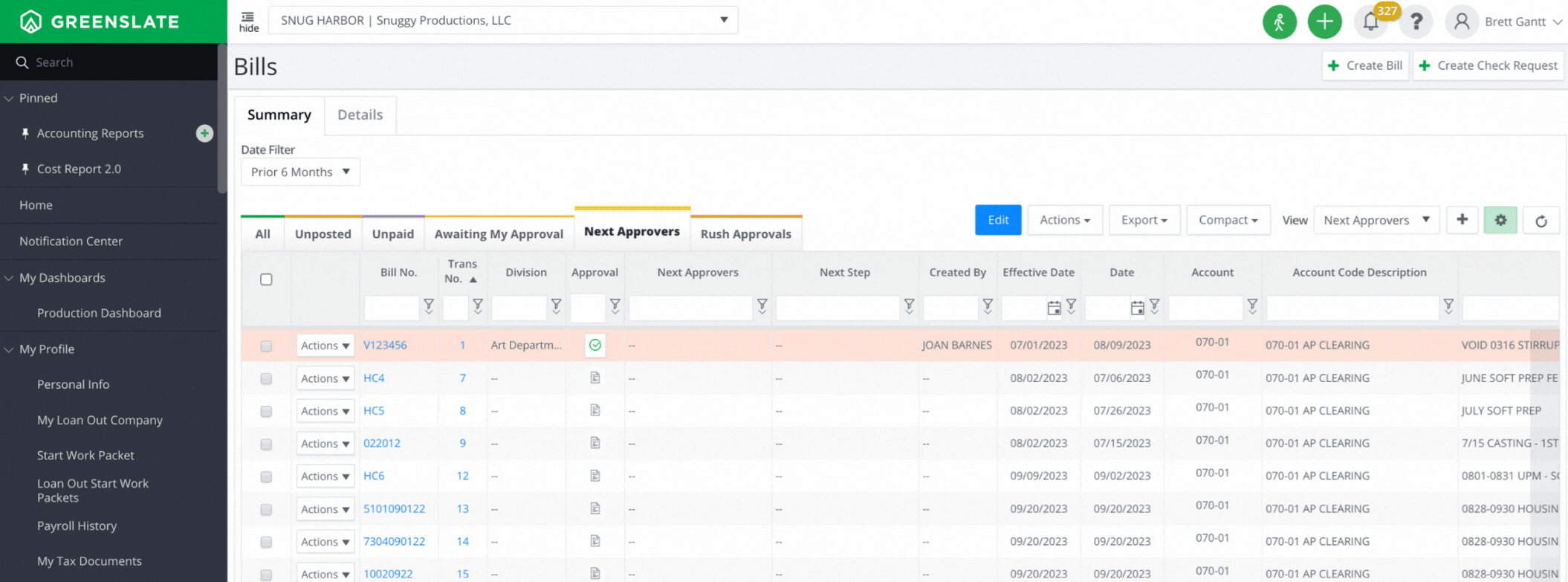
Each field in every module can be visible or hidden with one click. That means you can have access to only the information that is important to you.

You can even change the order of each item and arrange it in the way you want to see it simply by dragging and dropping it in whatever order you like.
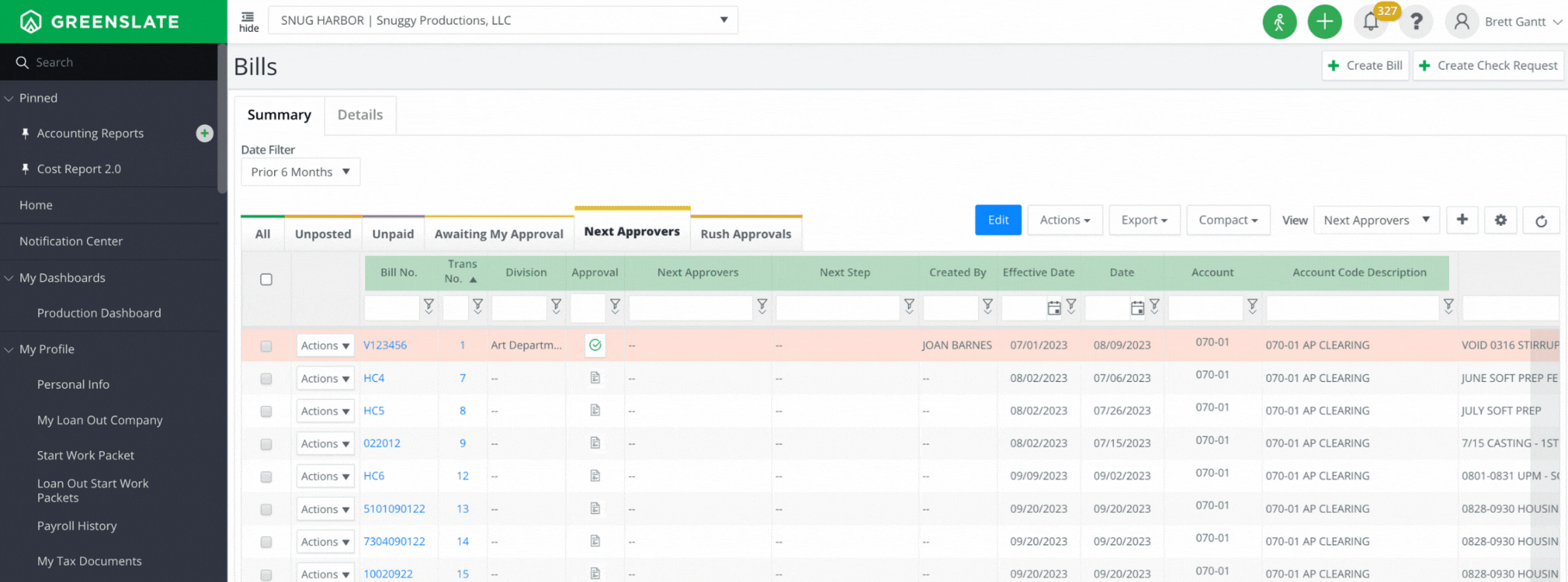
You can save your view, and easily toggle between the default and customs views you create.
FILTERING
Building on your mastery of Custom Views, the next time saving skill is filtering, where you can find items quickly through a filtered search. Whether you’re looking for one single transaction or many, every field can be filtered in every module.

There are so many use cases to employ filters, and with advanced filtering and sorting it’s easy to create custom reports. You can download your results in pdf, excel or csv files, so it makes creating detailed analysis and reporting quick and easy.
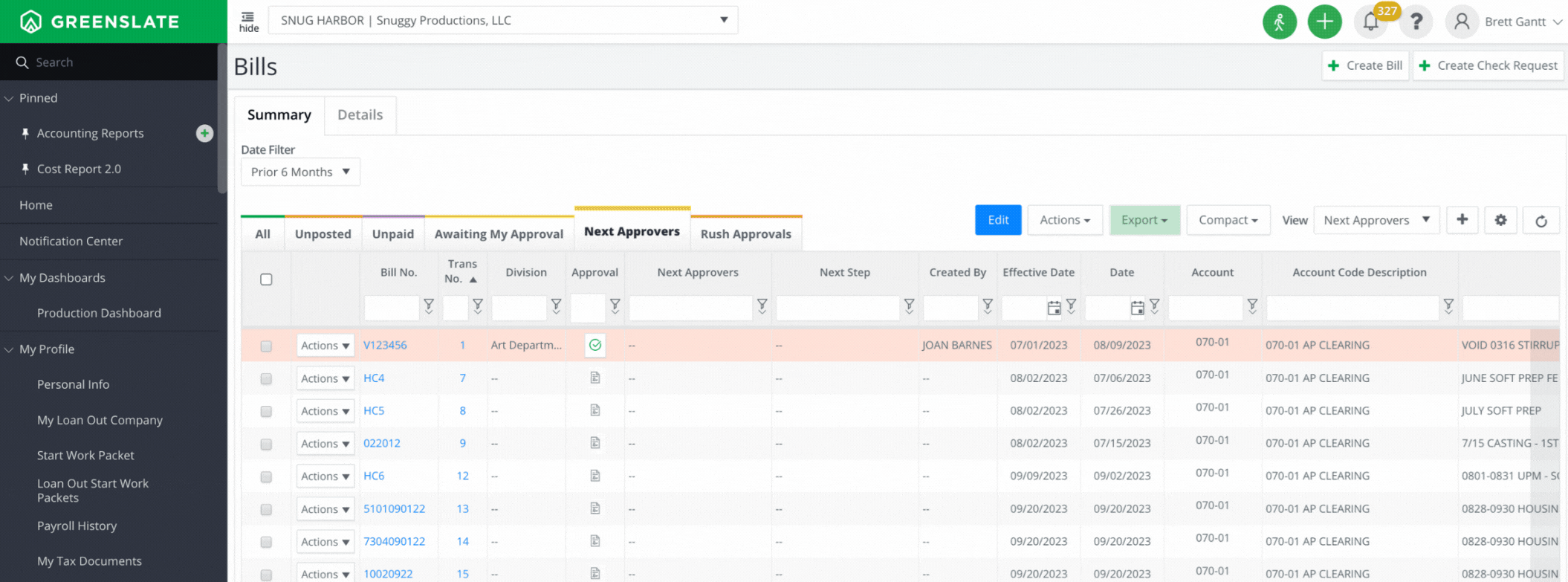
Learn to filter and get creative. I’m sure you’ll find your favorite.
RUSH APPROVALS
One essential feature in the world of production accounting is the Rush Approval. Knowing how and when to initiate a rush approval is important.
The mechanics are simple. In the bottom right corner of each module you will find the rush approval button. By default it is off. Simply click the rush approval button and provide the proper note to let everyone know why this item deserves special attention.
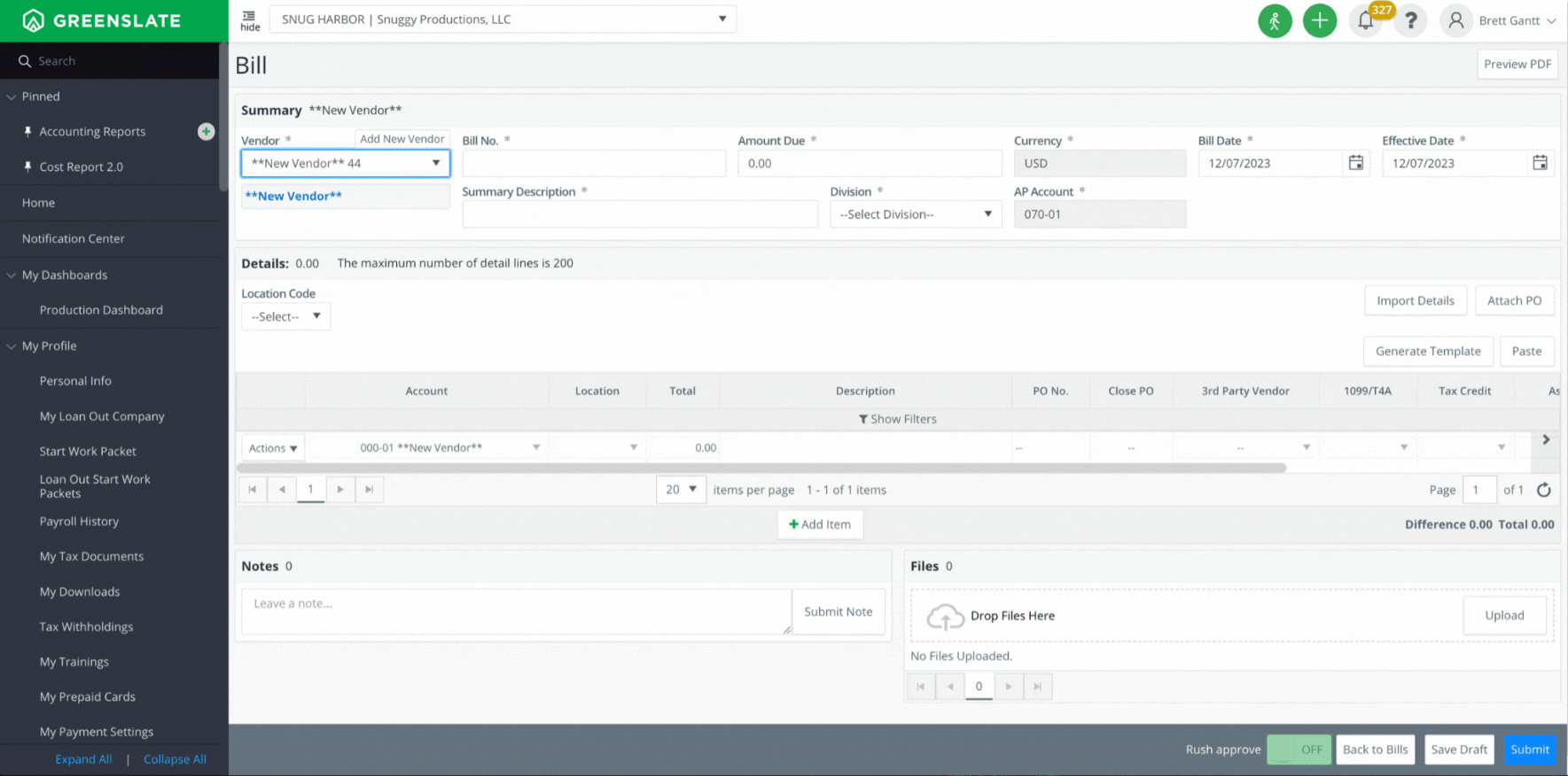
But with great power comes great responsibility! Use rush approvals wisely. Make sure every approver understands the importance of prompt attention to every rush approval. Also, limit your use of rush approvals for true rushes.
INTERMEDIATE
The next set of skills builds upon the solid foundation of the beginner set. Once we have our custom views, filtering and understanding of how to initiate rushes, we are ready to level up.
In our beginner section we addressed mostly the mechanics or “how to” do something, but now we need to address the “why.” This is where GreenSlate's tech and digital workflow is way more efficient than other systems that still rely on paper-based processes. To fully master them, let’s rethink an outdated process or two, and learn why we do things a bit differently.
RETHINKING BATCHES & EDITS
Let’s talk about Edits; their importance and their function. We also need to touch on the steps prior to batching and creating an edit in legacy systems. Once we unpack all of this we can see how our digital coding, editing and approval process is actually far superior to what you might be used to.
In the past you were accustomed to coding an invoice, sending it around for approval and then entering it into the system. Then after it has been entered, you have to check the input for accuracy.
Typically the 2nd assistant inputs the bills into the software and prints out an edit report. The report is attached to the batch of items included in the report. Those are passed along to the 1st to verify the information is correct. That is double work.
Think about this for a moment.
Most production accounting offices have made the move to enter purchase orders into the system before they have been fully approved. The advantage to this is that the committed costs are in the system sooner, and if for some reason the PO is not approved, it can be voided or deleted from the system.
And now it’s easy to adopt this approach to your invoices, petty cash and p-cards as well. It’s simpler to just check for coding errors and typos while approving. If there is something wrong with the coding or a typo in the invoice number etc., then make the corrections yourself or reject it and have the person who input it make the correction. Again, if the item is not valid or not approved, any approver can simply reject it.
Since each item goes through many sets of eyes along its approval journey, this simple change in the workflow actually provides more chances for scrutiny while saving time and making the process more efficient. That’s a win-win.
MANAGING & MONITORING APPROVALS
The value of our Digital Approval Flows is huge, check this out. Here’s a few time saving tips to master which build on all of the above.
GreenSlate has a couple of key views set up for you to manage your approvals status. These are, “Awaiting My Approval”, “Next Approvers” and “Rush Approvals”, but you can customize these even further through the use of filters.
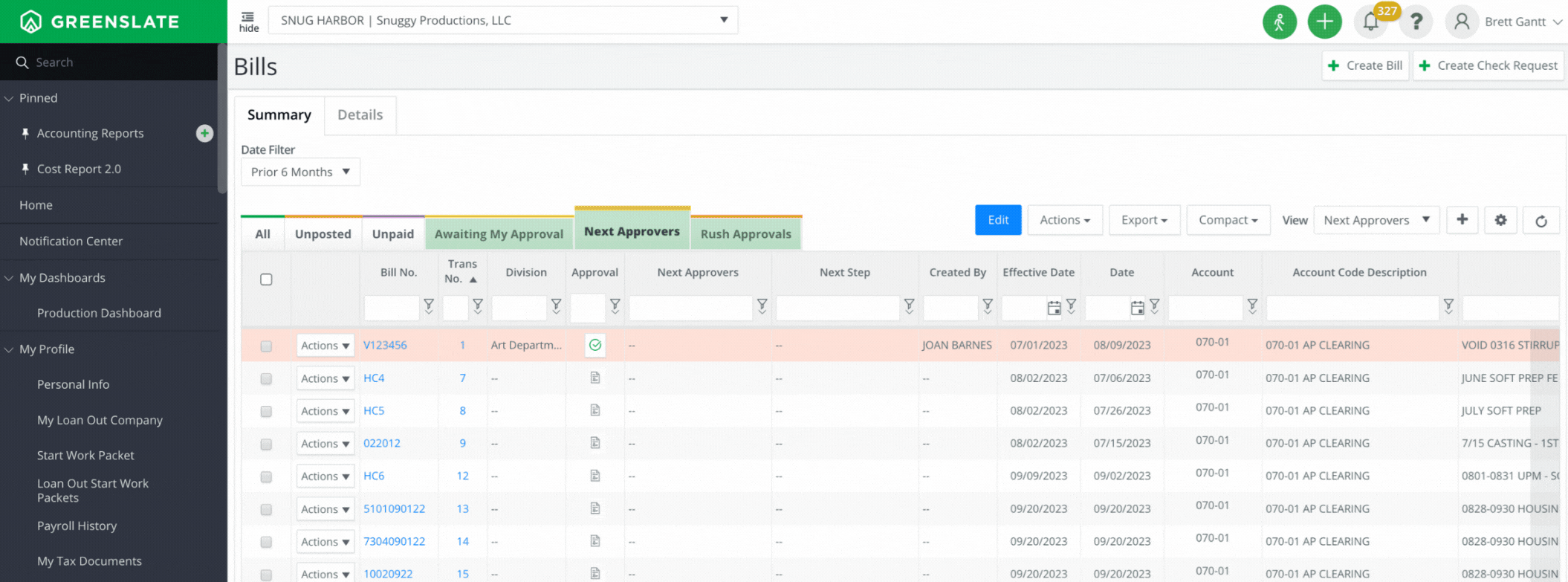
Now you can find the status of exactly what you are looking for, when it was first entered into the system and where it is in the approval flow. You can even ping the next approver all without leaving your desk.
Mastering these skills will save you tons of time for you and your team.
ADVANCED
Next up, we learn how to fine tune our reporting process. In GreenSlate, you have full control over when items hit the G/L and the ability to see how uncommitted items affect your cost report. It’s like seeing the future and being able give your producer or studio timely information to make better decisions.
COST REPORTING
I can’t imagine cost reporting without using custom views and filtering. There are some great default filters as well. One of my favorites is “Negative ETC’s”.

In fact, this is how I begin my cost reporting process.
Once I filter out everything except the negative ETC’s I can drill down into those accounts to make sure there are no mis-codings I need to move. Having the ability to drill down into the ledger directly from the cost reporting module is a huge time saver.
Couple that with the ability to initiate a distro change instantly from the drill-down window and you have cost reporting at light speed!
COMMITTING PO’S
Learning how and when to commit your fully approved PO’s is important. I would suggest viewing the uncommitted PO’s as you begin working on your cost report. That way you can see what is coming, and what you need to discuss with your producers and finance manager before you complete the report.

There are rare instances where you might want to hold off reporting something. (Have you ever had to use a negative dummy PO to temporarily remove an item so you could lock your cost report?)
Commit as many POs as you can before locking the cost report, and leave the questionable ones uncommitted until they have been sorted out. This is another big time saver! You don’t have to hold up the report until those items are resolved.
Also, and this is a big one… you don’t have to have your team hold off inputting or post dating items until your report is locked. You decide when to include them on your report!
UNDERSTANDING EFFECTIVE DATES
Remember when we used to have to post date items that we didn't want to be included in our cost reports? Well, when working with GreenSlate’s digital approvals, we need to fully understand when the costs hit our books. As noted above, even fully approved purchase orders are not included until they are committed.
When a bill, check request, petty cash or p-card transaction is entered into the system there is an effective date that is included. The date that the transaction was input is included by default, but until the item is fully approved the item will not appear in your cost reports. You can also post date items to appear in a future period as well, so there are a lot more options available to you once you realize how our process is quite a bit different than what you are used to.
Again, GreenSlate has empowered the advanced accountant to be able to work more efficiently and not hold up progress of the accounting team all while providing accurate and current information to the producers.
Welcome to the GreenSlate Mastery Club
Once you master the skills above, you’ll find that your days are shorter and less stressful.
If this has piqued your interest and you would like a demonstration or want to attend one of our seminars, we would be happy to help. You can reach out to me directly at brett.gantt@gslate.com or visit our website.
Topics:
Tech & Innovation
Brett Gantt
Brett Gantt is Senior Vice President, Head of Accountant Relations at GreenSlate. Gantt has over 20 years of production accounting experience with industry-leading content creators from studios to streamers, including Netflix, HBO (now Max), and ABC, and most recently independent powerhouse A24.
December 12, 2023
Related Posts
Access our blog for the inside scoop on what’s happening around the production office.
Get The Best of The Blog
Get the best of the GreenSlate blog once a month in your inbox by signing up for our GreenSlate Newsletter.
“If you're not using GreenSlate for processing production payroll, then you're not thinking clearly. We run about 10–12 productions a year and have used several of their competitors. I've put off sharing this as I've truly felt they've been a competitive advantage.”
Jeffrey Price
CFO at Swirl Films, LLC

